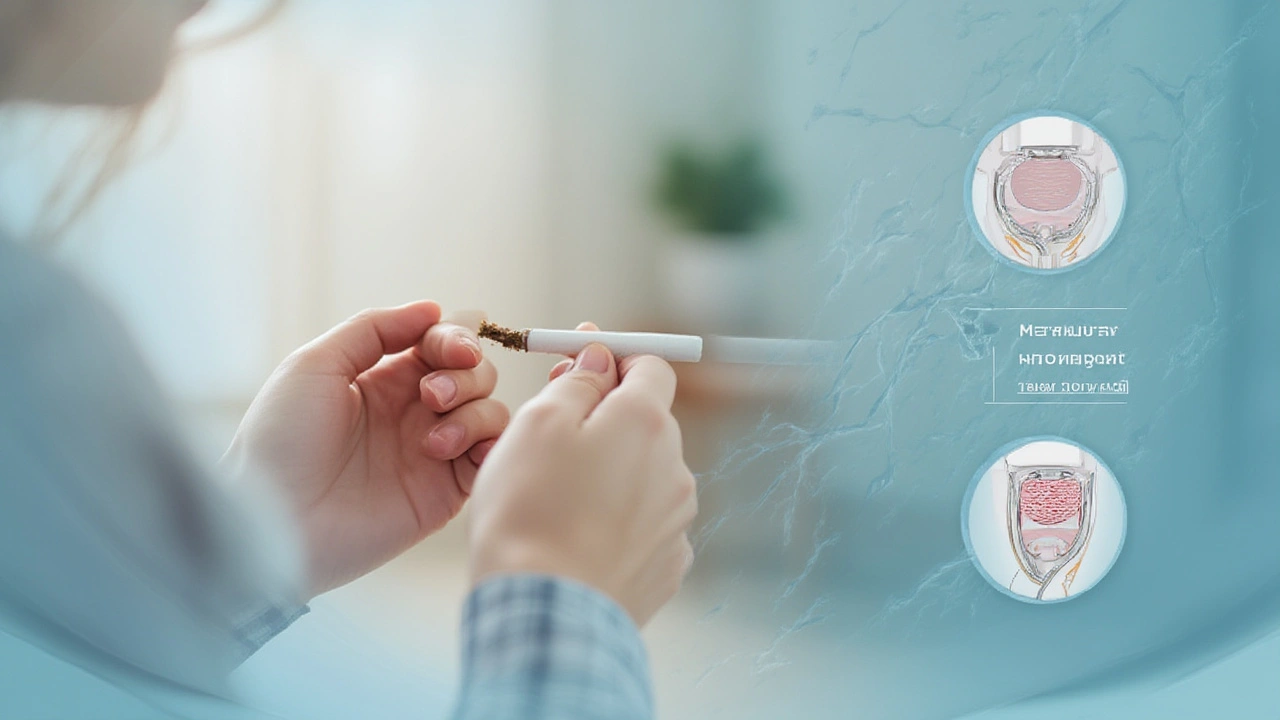Ever had that sudden, sharp urge to pee that feels impossible to hold back—and you’re sure you just went not long ago? Now, imagine being stuck in a never-ending cycle of those urges, sometimes shocking you with severe pain or involuntary bladder contractions. That’s the world of urinary tract spasms. If you’re reading this, maybe you smoke or once did, or someone you care about does, and you’re wondering: Could those tobacco habits be making your bladder rebel? Here’s the raw truth about how cigarettes and all things tobacco might trigger trouble in your urinary tract.
The Science: Bladder Basics and Why It Spasms
Let’s start with what has to go wrong for your bladder to spasm in the first place. Normally, your bladder wall is a flexible, muscular bag that expands as it fills with urine and quietly holds everything until you’re ready to let loose. This process is mostly automatic, with the muscle (called the detrusor) and your nervous system doing a balancing act. A spasm is when those bladder muscles contract suddenly and forcefully, sometimes without your say-so. This can mean urgency (that wild dash to the bathroom), pain, or even accidental leaks. Many things can cause these spasms—nerve disorders, infections, overactive bladder syndrome, even too much caffeine or alcohol. But in the last few years, research started to sniff out another troublemaker: tobacco.
How does nicotine manage to throw the urinary system into chaos? It acts as a stimulant throughout the nervous system. Bladder nerves are sensitive, and nicotine can irritate them, making them jumpy. Think of it like someone poking you repeatedly—eventually, you’re going to react. Tobacco smoke (and vaping, to a degree) sends not just nicotine, but a toxic cocktail of chemicals throughout the body. These can irritate bladder tissues and the nerves regulating how your bladder contracts. One major clinical study from Japan in 2021 actually found current smokers were 38% more likely to develop overactive bladder symptoms, especially frequent or urgent urination. That connection isn’t just a coincidence—it solidifies how tightly linked tobacco and urinary muscle spasms can be.
Another culprit is carbon monoxide and the thousands of other byproducts in cigarette smoke. These wreak havoc at a cellular level, causing inflammation. With inflammation comes swelling, and that’s a fast track to making bladder nerves hypersensitive. Suddenly, your bladder starts misfiring signals to the brain—empty now!—even when there’s barely any urine inside. This neurological confusion is the perfect storm for spasms to pop up.
So, if you’re someone who constantly feels uncomfortable or has sudden, urgent needs to urinate—especially with no sign of a urinary infection—your smoking habit could be a hidden trigger.
Breaking Down the Facts: Data and Studies on Smoking’s Impact
Numbers don’t lie, and the research into this topic has ramped up in recent years. One of the most striking statistics comes from a multicenter European study published in 2022, where smokers reported a 42% higher instance of sudden bladder contractions compared to non-smokers. The difference between light and heavy smokers? It’s not pretty. The more you smoke, the worse these symptoms tend to get. In fact, heavy smokers (defined as those with a history of more than 20 pack-years) showed bladder spasm symptoms twice as frequently.
Let’s get even more specific—here’s a snapshot of results from a review of several clinical trials:
| Group | Incidence of Bladder Spasms |
|---|---|
| Non-Smokers | 5% |
| Light Smokers | 13% |
| Heavy Smokers | 23% |
It isn’t just about frequency, though. Smokers also reported more severe symptoms, from pain to the dreaded bathroom sprints. Another factor? Age seems to make things worse—smokers over 50 were hit the hardest. That’s likely because bladder function naturally declines with age, so add in tobacco’s effects and you get a double whammy. And let’s not forget gender: women, often more vulnerable to bladder issues thanks to shorter urethras and hormonal shifts, have an even higher risk of spasms when combined with smoking.
What about vaping or smokeless tobacco? The data’s younger, but so far, nicotine replacement (like patches and gum) doesn’t seem to cause the same bladder havoc—possibly because it skips most of the other toxins. However, vaping with nicotine still appears to irritate the urinary tract in some cases, though not quite as brutally as cigarettes.
Another interesting tidbit: in a 2023 study out of the UK, adults who quit smoking saw improvements in their urinary symptoms within six months—some saying their urgency faded away entirely. So, the bladder can bounce back, even after years of abuse!

Signs, Symptoms, and When to Worry
Not every smoker will deal with obvious bladder trouble, but some red flags should make you sit up and pay attention. Watch for these signs that could point to urinary tract spasms linked to tobacco use:
- Sudden, hard-to-control urges to pee (especially when there’s little urine)
- Pain, burning, or a feeling of pressure down there with no infection present
- Waking at night just to go—sometimes multiple times
- Accidental leaks, especially during a laugh, sneeze, or without warning
- Sensation that your bladder never fully empties
Sound familiar? If you tick off a few of those, lighting up could absolutely be part of the picture. It’s also worth knowing that some conditions can sneak in and look similar. For example, bladder infections, kidney stones, and even prostate issues (for men) can mimic or add to these symptoms. If you notice blood in your urine, persistent pain, or suddenly can’t pee, see a doctor right away. Those are urgent red flags—don’t wait for things to sort themselves out.
It’s easy to brush off these symptoms as “just getting older” or “too much coffee,” but let’s not kid ourselves: our habits catch up to us. Smoking is a heavyweight risk for bladder cancer, too, which often starts with the same kind of symptoms. Bladder cancer rates are two to three times higher in smokers, so it’s definitely not something you want to ignore or try to tough out. Get checked if anything feels off for more than a few days.
Smart Tips: Easing Bladder Spasms and Quitting Tobacco
If you’re ready to ditch tobacco (your bladder and basically every other body part will thank you), know you don’t have to go it alone. First off, quitting isn’t a magic switch—sometimes those spasm symptoms stick around for weeks or even a few months. But most people notice big changes by six months. Here’s what gets you there faster, plus ways to manage symptoms in the meantime:
- Stay hydrated, but don’t drown yourself. Sipping water in small amounts all day is gentler on the bladder than gulping large amounts at once.
- Cut down on bladder irritants like caffeine, citrus, chocolate, and artificial sweeteners. They can rev up spasms.
- Try bladder training: Hold off urinating for a few extra minutes when the urge hits. Over time, this can stretch the periods between trips.
- Set a daily pee schedule, even if you don’t feel the urge—every 2-3 hours is a good start.
- Consider Kegel exercises. Yes, they aren’t just for pregnant women! Strengthening pelvic muscles keeps leaks in check and may calm spasms.
- Use nicotine patches or gum if you’re quitting to get past cravings without the bladder-damaging chemicals. These have way fewer side effects for most people.
- Talk to your doctor about bladder-calming medications if things get truly miserable—there are a few prescription meds proven to help relax bladder muscles.
The take-home message? Your bladder is way more sensitive than most of us ever guess, and smoking is absolutely a major trigger for spasms and other urinary problems. If you or someone you love is stuck in a cycle of running to the bathroom or unpredictable leaks, don’t just accept it. Pay attention to your habits, consider making a change, and remember—bodies can heal. Even quitting after years can give your bladder a serious break. Not sure where to start? Reach out to your doctor or a local quitline.
Bladder symptoms are your body’s way of speaking up when it’s sick of something. Listen to it. And if you’re reaching for that pack, just remember, sometimes the biggest wins start with saying no—one urge at a time.
